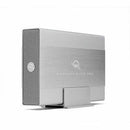Description
Designed for professionals who demand massive storage and dependable performance, the OWC Mercury Elite Pro USB 20TB external drive is the ultimate solution for archiving, backups, and on‑set media workflows. The 20 terabytes of capacity empower you to store multi‑terabyte video projects, large RAW photo libraries, and expansive backups without constantly swapping drives. Built around a rugged aluminum enclosure, this drive not only looks premium but also helps dissipate heat during long transfer sessions, keeping data safe and drive longevity high. With USB 3.2 Gen 1 (5Gb/s) connectivity, you can move large files quickly, whether you're editing 4K, rendering proxies, or delivering final masters to clients. It’s a plug‑and‑play workhorse that is as comfortable in a professional studio as it is in a home editing rig, making it an essential addition to any data‑heavy workflow.
- Massive 20TB capacity: Store tens of thousands of photos, millions of documents, and hours of 4K or higher‑resolution video. This is a storage upgrade you can depend on when managing large project libraries, performing long‑term archival, and maintaining robust backups without constantly swapping drives. The abundance of space helps simplify organization, safeguard important assets, and accommodate future growth as your workflow evolves.
- Blazing fast USB 3.2 Gen 1 (5Gb/s): Harness the power of a high‑speed interface designed to handle large media transfers with ease. Whether you're moving raw footage, multi‑gigabyte render files, or entire photo shoots, the Mercury Elite Pro USB minimizes wait times and keeps your creative momentum going. This performance is especially valuable in professional environments where time is money and delays can disrupt client deadlines.
- Durable aluminum enclosure with efficient heat management: The sleek, rugged chassis isn’t just for show—it provides durable protection and excellent thermal performance. Aluminum construction helps dissipate heat during sustained read/write tasks, reducing thermal throttling and helping to preserve drive health over years of continuous use. The result is reliable performance in studios, on location, or in a busy editing bay.
- Cross‑platform compatibility with simple setup: Built for versatility, this drive plays nicely with both macOS and Windows operating systems. It offers a straightforward plug‑and‑play experience and flexible formatting options, making it easy to configure Time Machine backups on Mac or NTFS/exFAT workflows on Windows. Whether you’re a freelance editor or part of a cross‑platform production team, you’ll appreciate the compatibility and ease of use.
- Ready‑to‑use kit and reliable reliability: Out of the box, you receive a high‑quality USB cable and an external power adapter, so you can start backing up and organizing your data immediately. The Mercury Elite Pro USB is engineered for long‑term reliability in demanding environments, delivering consistent performance for daily backups, media archiving, and large‑scale file transfers with minimal maintenance.
Technical Details of OWC 20TB Mercury Elite Pro USB (5Gb/s)
- Capacity: 20 TB
- Interface: USB 3.2 Gen 1 (5 Gb/s) for dependable, broad‑compatibility performance
- Drive Type: 3.5‑inch desktop external hard drive housed in an aluminum enclosure (internal HDD/SATA drive)
- Enclosure: Durable aluminum chassis designed for heat dissipation and rugged daily use
- Power: External power adapter required (not bus‑powered) for consistent performance and reliability
- Connections: USB Type‑A interface, compatible with USB‑C ports via standard adapters or USB‑C cables depending on host
- Compatibility: Optimized for cross‑platform use with macOS and Windows; supports Time Machine on Mac when reformatted accordingly
- Included accessories: USB cable and external AC power adapter
how to install OWC 20TB Mercury Elite Pro USB
- Unpack the Mercury Elite Pro USB drive and power adapter; ensure you are using the included cable and power supply.
- Connect the external power adapter to the drive and plug it into a reliable wall outlet; turn on the drive if it has a power switch.
- Plug the USB cable into the drive and connect the other end to an available USB port on your computer (USB‑A or via adapter for USB‑C host devices).
- Power on your computer if it is off; the system should recognize the drive automatically. On first connection, you may be prompted to initialize or format the drive depending on your OS.
- Format the drive for your preferred OS: exFAT for cross‑platform compatibility, APFS/HFS+ for Mac, or NTFS for Windows. Use Disk Utility (macOS) or Disk Management (Windows) to complete the format process, assign a name, and set up any needed partition scheme.
- Once formatted, you can begin backing up files, transferring large media, or configuring automated backups (Time Machine on Mac or Windows Backup/Restore on Windows). It’s recommended to create a dedicated backup plan to periodically verify data integrity and avoid accidental data loss.
Frequently asked questions
- What is the capacity of this drive? A: It offers 20 TB of storage space, suitable for large media libraries, backups, and archival storage.
- What interface does it use? A: It uses USB 3.2 Gen 1 with a maximum theoretical transfer rate of up to 5 Gb/s, providing solid throughput for multimedia workflows and backups.
- Does it require an external power supply? A: Yes. The Mercury Elite Pro USB relies on an external power adapter to power the 3.5" drive inside, ensuring stable performance during sustained transfers.
- Is it compatible with Mac and Windows? A: Yes. It is designed for cross‑platform use and can be set up for Time Machine on macOS or NTFS/exFAT on Windows, depending on your formatting choices.
- How should I format the drive for cross‑platform use? A: For cross‑platform access, format the drive as exFAT. For Mac‑only use, format as APFS or HFS+. For Windows, NTFS is common. Always back up data before reformatting, as formatting erases existing content.
Customer reviews
Showing - Of Reviews


